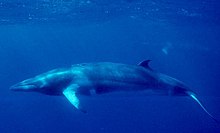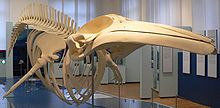Minke whale
| Minke whale | ||||||||||||
|---|---|---|---|---|---|---|---|---|---|---|---|---|

Minke whale "spy hopping" |
||||||||||||
| Systematics | ||||||||||||
|
||||||||||||
| Scientific name | ||||||||||||
| Balaenoptera acutorostrata | ||||||||||||
| Lacepede , 1804 |
The minke whale , minke whale or minke whale ( Balaenoptera acutorostrata ), in contrast to the southern minke whale ( B. bonaerensis ) also called the northern minke whale , is a species of furrow whale that occurs in all of the world's major oceans, most frequently in the North Atlantic and North Pacific.
In the southern hemisphere there is a population of minke whales that only reach relatively small body sizes and cannot be assigned to the southern minke whale. The exact classification is unclear. Possibly it is a subspecies of the minke whale or a previously undescribed furrow whale species.
features
For a baleen whale , the minke whale is quite small with a length of 6.8 to 9.8 meters - only the minke right whale is even smaller. Females can grow up to half a meter longer than males. The body is slender and streamlined, the fin on the rear third of the body is relatively high and sickle-shaped. The snout is pointed, the upper jaw triangular when viewed from above and has a small rostrum ridge in the middle. There are around 300 yellowish whiskers in the upper jaw . The number of throat furrows, which give the furrow whales their name, is 50 to 70.
The back is dark gray-brown or almost black, the sides blue-gray, the belly lighter. The transition between the dark back and the sides of the body is wavy and blurred. There may be some bright corners behind the head above the flippers . The dark flippers have a white band in the middle.
The population living in the southern hemisphere remains even smaller with a maximum length of 6.8 (females) to 7.8 meters (males). In terms of color, it differs slightly from the northern minke whale. Their whitish color on the abdomen extends over the flippers and continues as a gray, sickle-shaped, pointed arch upwards to the back. In front of the pinball machines, a dark band runs over the throat.
distribution
The northern minke whale occurs in the northern hemisphere of the earth, especially in the North Atlantic and North Pacific. It lives both oceanic and close to the coast and penetrates into estuaries, bays and fjords . In winter, warmer waters are preferred, in summer the species can also be found further north. Northern minke whales migrate further into the north polar drift ice belt than any other furrow whale. However, the seasonal hikes are irregular. Males and females and animals of different ages migrate separately. In general, males migrate further north and move more on the open sea, while females prefer the coastal waters and remain further south.
The southern population of smaller minke whales is sighted all year round in the Atlantic up to 7 ° S , in the Pacific up to 11 ° S. Most of the sightings are from the coast of South Africa , Australia and the Indian Ocean . In summer the animals are found in the same area as the southern minke whale. The southernmost sighting of a minke whale of this population was at 60 ° S.
Way of life
The minke whale lives individually or in loose groups of 2 to 3, less often from 5 to 15 animals. Seldom large gatherings of up to 400 animals occur in rich feeding grounds. It feeds on pelagic crustaceans , especially krill , and on small schooling fish, e.g. B. of herrings and sardines . Minke whales have a long mating season from December to June. The females probably give birth annually, after a gestation period of 10 to 11 months. The whale calf is 2.4 to 3.5 meters long and weighs around 450 kg from December to June, especially in warmer waters, and is then suckled for 4 to 6 months. Minke whales become sexually mature between three and eight years of age. Your life expectancy is likely a little under fifty years.
Minke whales are fast swimmers, can jump completely out of the water like dolphins and, unlike other furrow whales, are curious and approach ships.
Surface behavior

When the minke whales emerge, first the head appears at a low angle, then the blower . The fin is only visible after the bubble has disappeared. The descent takes place with a high, rapid rolling motion. Before diving deeply, the minke whale stands almost vertically and shows tail and fin, but no fluking. He can dive for at least 15 minutes but usually only dives for 6 to 12 minutes.
The bubble rises vertically, is usually less than two meters high and only poorly visible. The minke whale blows irregularly about five to eight times at intervals of less than a minute. The minke whale is curious about small boats.
Systematics
The minke whale was already in 1804 by the French naturalist Bernard Germain de Lacépède described . Most publications prior to 1990 assumed a single species of minke whale living in the world, and all minke whales in the southern hemisphere were considered conspecific to that in the northern hemisphere . However, since 2000 the Scientific Committee of the International Whaling Commission (IWC) has registered the southern minke whale ( B. bonaerensis ) as an independent species, which is separate from the northern minke whale and its even smaller dwarf population living in the southern hemisphere. Both minke whale species probably form the sister group to the other Balaenoptera species.
Whaling and Protection
Because of their small size and trusting nature, minke whales have always been easy to hunt. Whaling for minke whales has been guaranteed since the Middle Ages . But precisely in the time of the large whaling ships during the 18th and 19th centuries, minke whales were largely spared, as they were considered less commercially valuable than the other large whales . This is the only baleen whale that was still common in the middle of the 20th century. When the large whales were largely extinct in the 1960s, however, the hunt for minke whales was switched to. In the 1976/77 fishing season, 12,398 minke whales were killed. However, a whaling moratorium has existed since 1985, which also applies to the minke whale. Today (as of 2014/2015) around 1200 minke whales are caught annually by three countries: Norway with catch quotas of around 700 animals annually and Japan (approx. 300 animals annually) and Iceland (approx. 200 animals annually) for supposedly scientific purposes. In addition, individual animals are hunted by indigenous peoples in Greenland and Russia for subsistence purposes.
Japan withdrew from the International Whaling Commission in 2019 and can now legally hunt minke whales commercially again, as these are not classified as endangered species.
The global population is estimated at over 300,000 minke whales. The population is said to have increased since the beginning of the 20th century, as the sharp decline in the large whale population brought more favorable feeding conditions for the minke whale.
swell
literature
- Hadoram Shirihai : marine mammals. All 129 species worldwide. Illustrated by Brett Jarett. Franckh-Kosmos Verlags GmbH, Stuttgart 2008, ISBN 978-3-440-11277-9 .
Web links
- Balaenoptera acutorostrata in the endangered Red List species the IUCN 2008. Posted by: Reilly, SB, Bannister, JL, Best, PB, Brown, M. Brownell Jr., RL, Butterworth, DS, Clapham, PJ, Cooke, J. , Donovan, GP, Urbán, J. & Zerbini, AN, 2008. Retrieved April 18, 2012.
- Fahey, B. 1999: Balaenoptera acutorostrata , Animal Diversity Web. Accessed April 19, 2012
Individual evidence
- ↑ Shirihai: marine mammals. 2008, pp. 64-66.
- ↑ Shirihai: marine mammals. 2008, pp. 62-63.
- ↑ Shirihai: marine mammals. 2008, pp. 65-66.
- ↑ Shirihai: marine mammals. 2008, p. 64.
- ↑ Jennifer A. Jackson: Phylogenetics of Baleen Whales. doi : 10.1002 / 9780470015902.a0022870
- ^ SPIEGEL ONLINE, Hamburg Germany: Animal rights activist criticism: "Norway catches more whales than Japan and Iceland together". In: SPIEGEL ONLINE. Retrieved June 13, 2016 .
- ↑ Background information from WWF, pdf
- ↑ https://www.lto.de/recht/hintergruende/h/japan-austritt-walfangkonvention-voelkerrecht-moratorium-politik/
further reading
- Mark Carwardine : Whales and Dolphins. Delius Klasing, Bielefeld 2008, ISBN 978-3-7688-2473-6 (high quality guide).
- Ralf Kiefner: Whales & Dolphins worldwide. Pacific Ocean, Indian Ocean, Red Sea, Atlantic Ocean, Caribbean, Arctic, Antarctica. Year Top Special Verlag, Hamburg 2002, ISBN 3-86132-620-5 (guide to the magazine “tauchen”, very detailed).
- Jochen Niethammer, Franz Krapp (Hrsg.): Handbook of mammals in Europe. Volume 6: Marine Mammals. Part 1A: whales and dolphins. I: Daniel Robineau, Raymond Duguy, Milan Klima (eds.): Introduction, Monodontidae, Phocoenidae, Delphinidae. AULA-Verlag, Wiesbaden 1994, ISBN 3-89104-559-X (very detailed specialist book).
- Randall R. Reeves, Brent S. Stewart, Phillip J. Clapham, James A. Powell: Sea Mammals of the World. A complete Guide to Whales, Dolphins, Seals, Sea Lions and Sea Cows. A. & C. Black, London 2002, ISBN 0-7136-6334-0 (guide with numerous pictures).
- Maurizio Würtz, Nadio Repetto: Dolphins and Whales. White Star Publishers, Vercelli 2003, ISBN 88-8095-943-3 (identification book).




